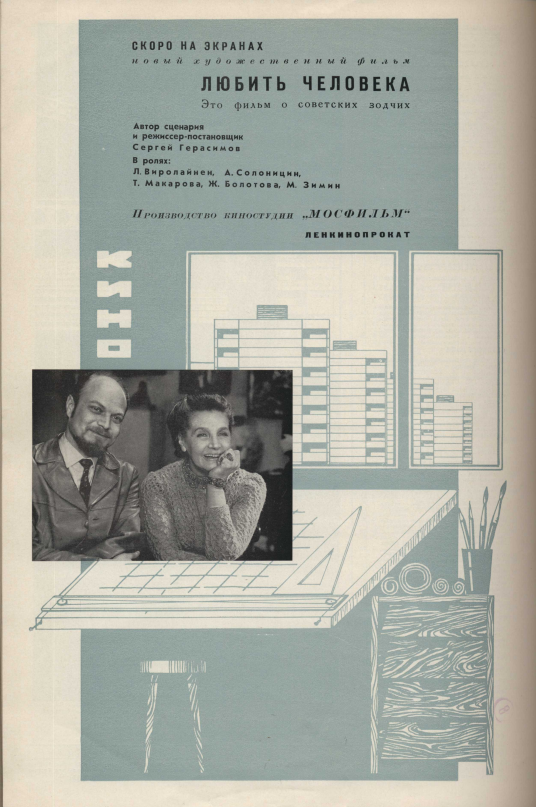(Russian: Любить человека)
Drama
Soviet Union, 1972
Director: Sergey Gerasimov
Film The Love of Mankind (L’ubit’ chelovika, literally “To Love a Human,” director Sergey Gerasimov, 1972) foregrounds a young architects’ couple, who meet at the studio of their former teacher and a chief architect Alexandra Petrushkova (an actual architect active in Moscow). The couple is based on architects Alexander Shipkov, the head architect of Norilsk in 1965-1967, and his wife Elizaveta Shipkova. Part of the film is set at the building of the House of New Everyday Life (currently dormitory of Moscow State University), designed by Petrushkova, Natan Osterman (head), I. Kanaeva, G. Konstantinovsky, and G. Karlsen in Moscow in 1965-1971. Architect Rimma Aldonina appears in the film in a background role of an architect.
The protagonist, Dmitry, played by Anatoly Solonitsyn (who had also famously starred in Andrey Tarkovsky’s films), had recently accepted a position in the north of Siberia (Norilsk, where the film was shot, is not named but is the presumed location): despite the harsh climate and meager living standards, he is excited about this job, which offers him the freedom of designing new architecture for the new society. Dmitry is portrayed as a genius almost obsessively dedicated to his calling–the transformation of people’s life and social conditions in the far North, which is reflected in the film’s title.
Unlike him, his wife Maria (the Christian connotation is not coincidental) is depicted as lacking a particular talent in architecture. Instead, her calling–the female version of the love for a human–is to support Dmitry and to bring him a child. When Maria confers to Dmitry her desire to become a mother, he responds: “But how [are we] to work?” “Not everyone is to build houses,” Maria retorts, “[giving birth] is our, women’s, foremost work [samoe nashe bab’ie delo].” His argument that “This is not why we came here” does not make sense for her. Maria is also able to mitigate Dmitry’s lapses of creative egocentrism and, while encouraging him to fight for his highly ambitious project, remind him that he must not forget the immediate needs of people in need of housing.
The third character in the film, Maria’s girlfriend Tatyana, also an architect, is more talented and independent than Maria–yet, she lacks the coherence and a sense of life mission that Maria achieves in marriage. The film shows Tatyana experiencing sexual harassment from a senior male colleague, which she sustains with indifference testifying to how common such worksplace assaults were. Early in the film, we also see her breaking up a relationship with an architect-fiance: “I am a hundred times smarter than you, smarter and more talented. […] Your sole advantage is [your] pants.” Yet, intellect and talent do not bring happiness to Tatyana, who lacks male genius or the male sense of professional calling.
The film’s characters represent social and professional expectations of the time: unlike a man, who was “naturally” destined for the public sphere, a woman, even if she was equally talented and educated, could be truly happy only at home.


The Love of Mankind, part 1: https://www.youtube.com/watch?v=riiktaWO0iE
The Love of Mankind, part 2: https://www.youtube.com/watch?v=He23nil7XTc
Fig. 1: Liub. ch-ka-advert Stroit-vo i arkh. Leningr. n.12 1972, in public domain.
Fig. 2: https://upload.wikimedia.org/wikipedia/ru/5/5d/%D0%9F%D0%BE%D1%81%D1%82%D0%B5%D1%80_%D1%84%D0%B8%D0%BB%D1%8C%D0%BC%D0%B0_%C2%AB%D0%9B%D1%8E%D0%B1%D0%B8%D1%82%D1%8C_%D1%87%D0%B5%D0%BB%D0%BE%D0%B2%D0%B5%D0%BA%D0%B0%C2%BB_%28%D0%A1%D0%A1%D0%A1%D0%A0%2C_1972%29.jpg (last accessed on 22.07.2022)
We assume that all images used here are in public domain. If we mistakenly use an image under copyright then please contact us at info@womenbuildingsocialism.org or here.